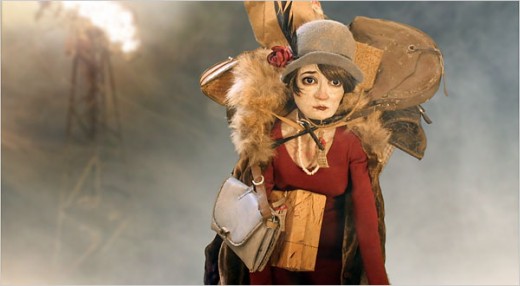Search ResultsFor "nutzi land"
Disney &Fleischer &Illustration &repeated posts 24 May 2012 05:16 am
Sheet Music Graphics – repost
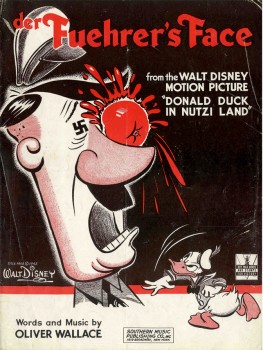 – I’ve long been a fan of old sheet music and have a tiny collection of songs from animated pictures.
– I’ve long been a fan of old sheet music and have a tiny collection of songs from animated pictures.
This is a song by Oliver Wallace in the Donald Duck cartoon, Der Fuerher’s Face. The sheet music is a bit rare in that it has the original title of the Donald film, Donald Duck In Nutzi Land.
They soon changed the title on the sheet music, especially after the music became a #1 hit in a version by Spike Jones & His City Slickers.
You can see the film on the Walt Disney Treasure DVD – On The Front Lines: Disney Goes To War.
The film deservedly won the Oscar for Best Short Subject in 1942. Its opposition were all propaganda war films.
.
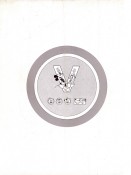
.
- Here’s part of the back page, for those who want to see the Disney logo for sheet music back then.
Sheet music in the 30s, 40s and 50s was Big Business. There were no DVDs,videos or LP records. No walkman, I Tunes or cel phones. Selling sheet music for all those kids learning to play an instrument was the natural tie-in to the film, and gave the Nation another inroad to marketing the film.
If the audience hummed the song, more tickets could be sold to the film.
.
The graphics for the music to Song of The South wasn’t quite as dynamic as the one on the cover of Der Fuehrer’s Face.
This cover tries to capture the lyrical, romantic feel of the film. Here surrounding the live-action plantation, with all the different song titles available from the film in the sky, is a border consisting of the animated characters from the film. The colors are limited to the green-etched homestead and the brown-linear characters.
The back cover of the sheet music contains a shot of the live-action characters, James Baskett, Bobby Driscoll, and Luana Patten. All are colored in the same brown ink as the cover’s line art.
That year “Zip-A-Dee-Doo-Dah“, also from this film, won the Oscar, while the film’s music, itself, was nominated for Best Scoring of a Musical Picture.
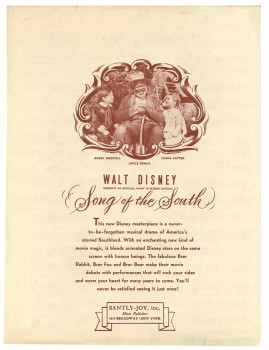 This film made quite an impression on me when I was a kid. And this song was one of the two I played over and over from the record. I also loved “Laughing Place”.
This film made quite an impression on me when I was a kid. And this song was one of the two I played over and over from the record. I also loved “Laughing Place”.
It’s something of a shame that the film has been kept out of circulation in the US. I can’t imagine that the film affected me as a child in any negative way. Uncle Remus was clearly the hero of the film and the only truly positive adult character in the film.
The last time I saw the film projected was back in the 70′s when Disney set themselves up at Lincoln Center to show a complete retrospective of ALL their films. At the library auditorium behind Lincoln Center there were a number of seminars in which Frank Thomas, Ollie Johnston, Ken Andersen and Woolie Reitherman talked about their work.
I remember Frank Thomas talking about this feature, saying that Disney only did the best for the film hiring the greatest cinematographer, Gregg Toland, to shoot it. He’d shot everything from Citizen Kane to The Grapes of Wrath. (Both are unbelievably stunning works of cinematographic art.) What Thomas didn’t say, or didn’t realize, however, was that this was Toland’s first COLOR feature. And it showed. Garish, cartoon colors flooded the screen, with actors wearing much too much makeup. A big step for Toland but not the best photography.
Still, I remember those colors vividly, and I would love to see it again – on screen. A dvd would probably do.
– I have a non-Disney cover. It’s the 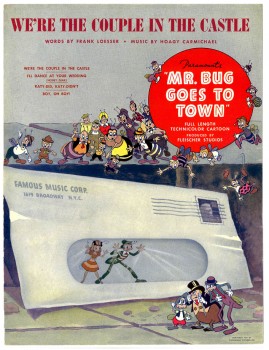 sheet music for the 2nd feature film from the Fleischer’s, Mr. Bug Goes To Town.
sheet music for the 2nd feature film from the Fleischer’s, Mr. Bug Goes To Town.
This was a feature that really got me going when I was young. I think it was the first original story done in animation; not an adapted fairy tale or novel. The story still works for me, though it comes off as a bit episodic. (Actually, I think most animated features are too episodic.) They’ve created a complete world for these insects, and it works.
Technically the film is a bit limited. The opening title shot is a stunning shot panning down the Empire State Building and across NYC ending on the vacant lot where the bugs live. The animation is adequate for the period; it has a charm that I find delightful and sometimes exciting. The voices are good, and the music is excellent.
This was the hit song, written by the brilliant Hoagy Carmichael (who wrote Stardust, Heart and Soul, and Skylark) and the just-as-brilliant Frank Loesser (who wrote Guys and Dolls, Hans Christian Andersen, and How To Succeed In Business). The score for the film was co-written by Leigh Harline (who scored Pinocchio, a lot of Disney shorts, and The 7 Faces of Dr. Lao, among others).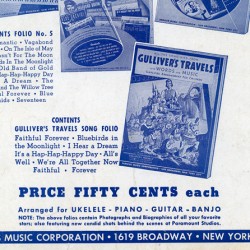
As we can see, most sheet music was printed with one or two colors) red for Der Fuehrer’s Face, brown & green for Song of the South) as opposed to full color. However, this Fleischer song has a full color cover (although they use one color on the rear cover). It shows that Paramount felt they had a hit song here, and they did have a modest hit. Glenn Miller’s recording of it didn’t hurt.
The rear cover is little more than an ad for other Paramount songs. However, in among the group is Gulliver’s Travels. I’m posting just this small section of the back cover, printed in blue.
.
.
Daily post 16 Feb 2008 09:37 am
Academy rush
- Oscar season is winding down as we approach the event next Sunday. Magnolia Pictures is distributing the live action and animated shorts to theaters across the country. In New York, the program opened yesterday at the IFC theater. The reviews in the local papers have been glowing. Stephen Holden‘s NY Times review places particular focus on Madame Tutli-Putli, as well as My Love and Peter and the Wolf. They deserve the attention. I look forward to seeing which film will win.
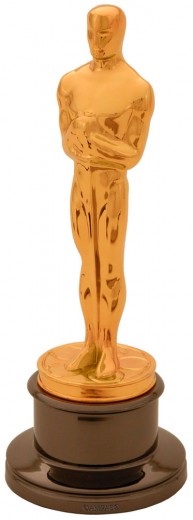 This past Wednesday, the Academy screened the four documentary short films nominated. They were an interesting and varied group and almost any of them might make for passable winners. I was taken, however, by one film called Sari’s Mother. It followed a mother living on a farm in Iraq trying to take care of a son who was infected with the AIDS virus. She had many other kids to attend to, and still had to follow through with all her attention given to Sari, trying desperately to get helpful medication that the boy wasn’t allergic to.
This past Wednesday, the Academy screened the four documentary short films nominated. They were an interesting and varied group and almost any of them might make for passable winners. I was taken, however, by one film called Sari’s Mother. It followed a mother living on a farm in Iraq trying to take care of a son who was infected with the AIDS virus. She had many other kids to attend to, and still had to follow through with all her attention given to Sari, trying desperately to get helpful medication that the boy wasn’t allergic to.
The film was different from the others screened in that it told its story without a narrator. There was little dialogue throughout the film, yet a complex story was told. Everything from the army of US soldiers everywhere in sight, including loud, roaring helicopters overhead, to many children playing. We were left to figure out the story for ourselves. There was never even a statement that the film took place in Iraq. (For a while, I actually thought it might have been Afghanistan.) I liked being given credit for using my own intelligence with the movie.
After the event, Shiela Nevins and HBO sponsored a post-screening dinner at the Four Seasons Hotel. All of the key documentarians in the City usually attend, and it’s a wonderful event that I look forward to annually. It always sort of marks the end of the Oscar run, for me. I was pleased to sit with John Canemaker and Joe Kennedy. I was able to pump John to tell me about the Annie Award ceremony and his trip to LA.
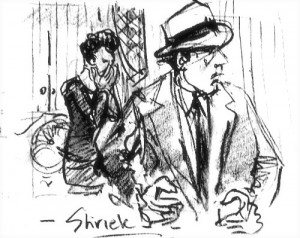 - Premier NY artist Meryl Rosner has done an interesting exercise and posted it on her blog Zoopolis, Film Noir, Fractured Fairy Tales. She’s taken a sequence from The Big Sleep and has storyboarded it. What a great idea, not only as a way of studying a film, but as a way of learning how to storyboard. Taking an excellent film, as Meryl has done, gives you the chance to see and to try to understand why the cuts and transitions, the camera placement and the compositions are done as they are.
- Premier NY artist Meryl Rosner has done an interesting exercise and posted it on her blog Zoopolis, Film Noir, Fractured Fairy Tales. She’s taken a sequence from The Big Sleep and has storyboarded it. What a great idea, not only as a way of studying a film, but as a way of learning how to storyboard. Taking an excellent film, as Meryl has done, gives you the chance to see and to try to understand why the cuts and transitions, the camera placement and the compositions are done as they are.
To boot, Meryl’s done a good job of it. Scrolling down through all these storyoard drawings is exciting in itself. If you visit, take a look at some of her other pieces as well.

- The NY Times, this week, has posted Jeff Scher‘s latest video for them on their editorial page. The Animated Life is a series he has been creating. Once a month a new film piece is place on the on-line editorial page.
Tulips is an animated study of kissing.
Take a look.
Michael Barrier has written a couple of times about this theatrical muscal. I saw a short review in the SF Weekly. The review’s almost too short to quote, so I include it all.
- Disney & Deutschland
By Molly Rhodes
 Imagining the details of a historically documented 1935 meeting between Walt Disney and Adolf Hitler is a great spark for a play, but playwright and director John J. Powers’ production never ignites. The 20-minute history lesson that starts the 90-minute play fails to build up the excitement before the big get-together. Once Disney and Hitler are in the same room, along with Hitler’s right-hand man, Joseph Goebbels; and his personal filmmaker, Leni Riefenstahl; there is hardly any dramatic action to push the play along. There are occasionally tense moments, such as when Hitler wonders how much of a Jew-hater Disney really can be if he works in Hollywood. But most of the hour is spent sitting around a big oak table, drinking sherry, and swapping tales of German efficiency and American pluck. Powers teases us with some provocative themes, such as the true roots of Disney’s fantasy playland for children, but the tease never pays off.
Imagining the details of a historically documented 1935 meeting between Walt Disney and Adolf Hitler is a great spark for a play, but playwright and director John J. Powers’ production never ignites. The 20-minute history lesson that starts the 90-minute play fails to build up the excitement before the big get-together. Once Disney and Hitler are in the same room, along with Hitler’s right-hand man, Joseph Goebbels; and his personal filmmaker, Leni Riefenstahl; there is hardly any dramatic action to push the play along. There are occasionally tense moments, such as when Hitler wonders how much of a Jew-hater Disney really can be if he works in Hollywood. But most of the hour is spent sitting around a big oak table, drinking sherry, and swapping tales of German efficiency and American pluck. Powers teases us with some provocative themes, such as the true roots of Disney’s fantasy playland for children, but the tease never pays off.
Details:
Through Feb. 24 at the Garage, 975 Howard (at Fifth St.), S.F. Tickets are $10-$20; call 829-2301 or visit www.975howard.com.
Commentary 22 Mar 2007 08:40 am
Nuts
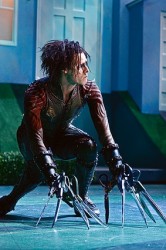 – Last night I got to see Edward Scissorhands, the Mathew Bourne ballet at the Brooklyn Academy of Music. (Watch BAM’s video montage here.)
– Last night I got to see Edward Scissorhands, the Mathew Bourne ballet at the Brooklyn Academy of Music. (Watch BAM’s video montage here.)
I like Bourne’s choreography; it seems to fit somewhere between Jerome Robbins and Mark Morris.
Caroline Thompson, who wrote the script for the original film, reworked the story for the ballet. (She also wrote Corpse Bride and Nightmare Before Christmas.)
Danny Elfman, who did the score for the movie added to the score for the ballet.
So, the set was beautiful, gorgeous costumes, original writer and composer, and I liked the choreography. What was wrong? Why didn’t I find it thrilling?
Five words: Johnny Depp, silence & Tim Burton.
(Click any image to enlarge.)
If you’re out to rework a movie that a lot of people love – and a lot of people love this movie – you’d better top it. That means you have to find an approach that is different than and better than Johnny Depp‘s character. Depp IS Edward Scissorhands! In the Bourne production, we had an imitation of the personality Depp created for that film. It was an original, and it can’t be duplicated by someone else, or it ends up feeling like one of those stuffed people dressed like Mickey Mouse and Goofy wandering around Disneyland. (A small side note: I once asked my young niece and nephew, who watched tv with me as Michael Eisner cavorted with people dressed like Donald and Mickey, if that was the REAL Donald and Mickey. They categorically said, “No!” The real characters were cartoons.)
Johnny Depp was being impersonated in this ballet, and the real guy was a pirate in a sequel coming out this summer.
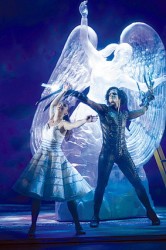 In the movie, Depp’s character was silent; everyone else talked. In the ballet, no one talked. This takes away from Edward’s character. He obviously CAN talk, now, since no one talks in this version – they performed mime to tell the story. Everyone was Edward Scissorhands.
In the movie, Depp’s character was silent; everyone else talked. In the ballet, no one talked. This takes away from Edward’s character. He obviously CAN talk, now, since no one talks in this version – they performed mime to tell the story. Everyone was Edward Scissorhands.
Tim Burton is an original. Go from Edward Scissorhands to The Corpse Bride to Willy Wonka to The Nightmare Before Christmas to Big Fish. No one has to tell you that Tim Burton made those films (with and without Caroline Thompson.) The ballet tried to recreate the movie; they tried to recreate Tim Burton. I’m sorry but originality can’t be duplicated.
I’m glad I saw the ballet, but I’d have preferred something original.
You can see more video clips on YouTube: go here.
 – Last year I posted the sheet music cover and talked about the animated short, Donald In Nutzi Land or, Der Fuehrer’s Face (after the name change).
– Last year I posted the sheet music cover and talked about the animated short, Donald In Nutzi Land or, Der Fuehrer’s Face (after the name change).
Now on the site Toons At War layout drawings for this sheet music have been posted. You’ll find a lot of other documents about the film there as well.
Bob Thomas, in the original The Art of Animation (1958) wrote the following story from composer, Oliver Wallace:
-
A favorite story of his concerns the time when Walt returned from Washington in wartime.
“I need a song for a cartoon the government wants me to do about the enemy,” Walt said. “It’s got to be serious, but funny.”
“You mean serious to them but funny to us?” Wallace suggested. (Click any image to enlarge.)
“Yes,” Walt replied.
The composer went home that evening, had dinner and took a nap. His wife asked him
to bicycle to the market with her. As he pedaled, a marching tune began to come to him.
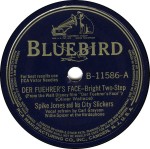 His wife lost him in the market and finally discovered him leaning against a wall and tapping his foot. When he got home, he went to work. In an hour and a half, the words and music to “Der Fuehrer’s Face” were ready for the publisher. Both the song and the Donald Duck short were hits. “Der Fuehrer” was hailed by Oscar Hammerstein II as the great psychological song of the war.
His wife lost him in the market and finally discovered him leaning against a wall and tapping his foot. When he got home, he went to work. In an hour and a half, the words and music to “Der Fuehrer’s Face” were ready for the publisher. Both the song and the Donald Duck short were hits. “Der Fuehrer” was hailed by Oscar Hammerstein II as the great psychological song of the war.
To hear the song as played by Spike Jones & His City Slickers go here.
The film is available on the Disney Treasures dvd On The Front Lines – Disney Goes To War.
Michael Barrier is hooked, and we benefit. He not only released the Draft for the Disney masterpiece, Who Killed Cock Robin?, but he’s produced a “Mosaic” Ã la Mark Mayerson. This, along with his Capsule notes on the film, give the short quite an analysis. Show and tell isn’t always enough. Good commentary is necessary. That’s where Mike Barrier and Mark Mayerson’s sites excel far beyond most. (Originality. I’ve heard that word before, somewhere.)
Animation Artifacts 09 Jun 2006 07:06 am
Der Fuerher’s Face
 – I’ve long been a fan of old sheet music and have a tiny collection of songs from animated pictures. I’m going to post a couple of them in the next week.
– I’ve long been a fan of old sheet music and have a tiny collection of songs from animated pictures. I’m going to post a couple of them in the next week.
This is a song by Oliver Wallace in the Donald Duck cartoon, Der Fuerher’s Face. The sheet music is a bit rare in that it has the original title of the Donald film, Donald Duck In Nutzi Land.
They soon changed the title on the sheet music, especially after the music became a #1 hit in a version by Spike Jones & His City Slickers.
You can see the film on the Walt Disney Treasure DVD – On The Front Lines: Disney Goes To War.
The film deservedly won the Oscar for Best Short Subject in 1942. Its opposition were all propaganda war films.
(All images can be enlarged by clicking.) 
- Here’s the back page for those who want to see the Disney logo for sheet music back then.
- Continuing the musical thread, I love these musical objects found on Fwak Grab Bag (an entertaining site.)
- For those searching for CARS reviews by non-animation reviewers here are three from NYC: one glowing (NYDaily News), one mixed/negative (Village Voice), one negative (NYTimes).
